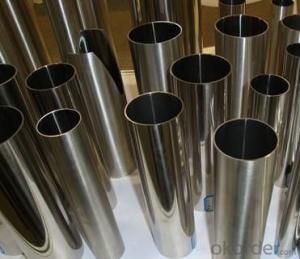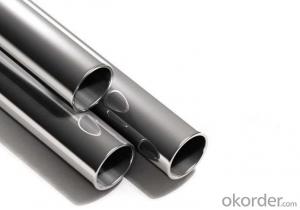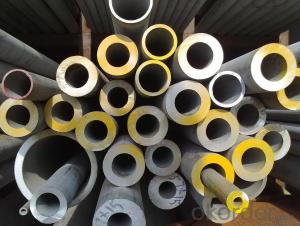201 304 2B Stainless Steel Pipes
- Loading Port:
- China main port
- Payment Terms:
- TT OR LC
- Min Order Qty:
- 5 m.t.
- Supply Capability:
- 100000 m.t./month
OKorder Service Pledge
Quality Product, Order Online Tracking, Timely Delivery
OKorder Financial Service
Credit Rating, Credit Services, Credit Purchasing
You Might Also Like
Item specifice
Standard:
AISI,JIS,GB,BS,DIN,API,EN,ASTM
Technique:
Hot Rolled,Cold Rolled,Cold Drawn,ERW,Forged,Saw,Extruded,EFW,Spring
Shape:
U Channel,Square,C Channel,Hexagonal,Round,Rectangular,Oval,LTZ
Surface Treatment:
Galvanized,Coated,Copper Coated,Color Coated,Oiled,Dry,Chromed Passivation,Polished,Bright,Black,PVDF Coated
Steel Grade:
Q195,Q215,Q235,Q215B,Q235B,RHB335,HRB400,200 Series,300 Series,400 Series,600 Series,SS400-SS490,10#,20#,A53(A,B)
Certification:
ISO,SGS,CE
Thickness:
as required
Length:
12m
Net Weight:
as required

201 304 2B Stainless Steel Pipes
Specifications
Description: 301 304 410 430 stainless steel pipes with ASTM JIN standard
Material: 200#, 240#,320#,500#,600#, etc.
Outside Diameter: 9mm~216mm
Wall thickness: 0.3 mm ~ 3.0 mm
Length: as your requirement
Application: best selling stainless steel pipes applies to petroleum, chemical industry, electric power, boiler, high temperature resistan
Technique: cold rolled
Standard: AISI, ASTM, GB, JIS
Products Show
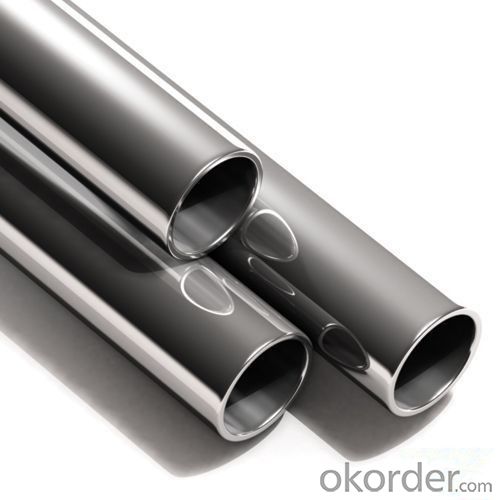

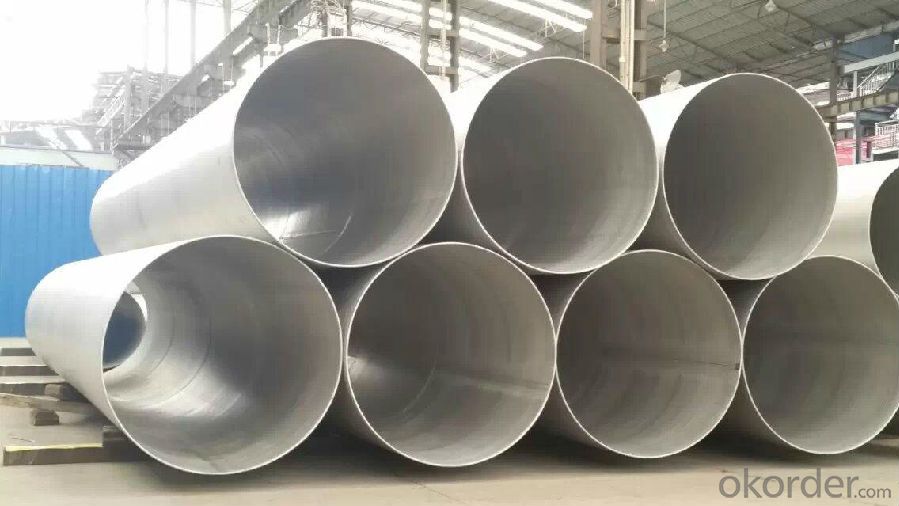
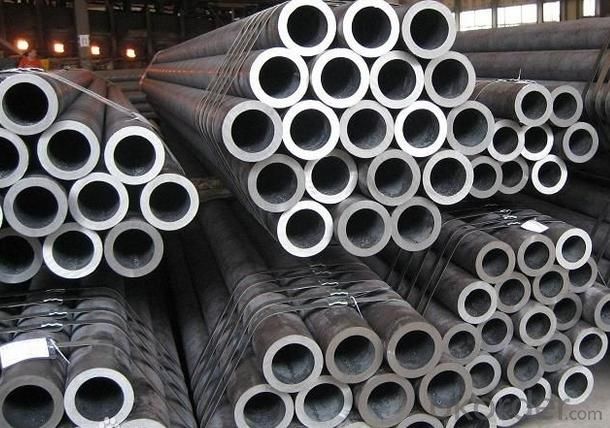
- Q:Can stainless steel pipes be used for transportation of hazardous materials?
- Yes, stainless steel pipes can be used for the transportation of hazardous materials. Stainless steel is known for its corrosion resistance, high strength, and durability, making it suitable for handling various types of hazardous substances. Stainless steel pipes are commonly used in industries such as chemicals, petrochemicals, oil and gas, and pharmaceuticals, where the transportation of hazardous materials is a regular occurrence. Stainless steel's resistance to corrosion ensures that it can withstand exposure to a wide range of chemicals without degradation. This is particularly important when transporting hazardous materials that could potentially react with or corrode other materials. Stainless steel pipes also have high strength, which allows them to handle the pressures and stresses associated with the transportation of hazardous materials. Furthermore, stainless steel pipes can maintain the integrity of the hazardous material being transported by preventing contamination from external sources. Stainless steel is inert and has a smooth surface, making it resistant to the formation of deposits, which can potentially react with or contaminate the hazardous materials. It is important to note, however, that the selection of stainless steel grade and its compatibility with the specific hazardous material being transported should be carefully considered. Different stainless steel alloys have different characteristics, so it is crucial to choose the appropriate grade that can withstand the specific chemical properties of the hazardous material. Additionally, regulations and standards regarding the transportation of hazardous materials should always be followed to ensure safety and compliance. These regulations may include specific requirements for the design, fabrication, and testing of the stainless steel pipes used for transportation. In conclusion, stainless steel pipes can be effectively used for the transportation of hazardous materials due to their corrosion resistance, strength, and durability. However, it is essential to consider the specific requirements of the hazardous material and adhere to relevant regulations to ensure safe and efficient transportation.
- Q:Why can't stainless steel tubes be cut with acetylene?
- That is because the iron element in the high temperature, if the above 99,6% will occur on the oxygen oxidation phenomenon is very strong, because of the heat transfer cycle, in order to make the cutting to continue uninterrupted, continuous heating it when cutting calories.
- Q:What is the difference between 430 and 316 stainless steel pipes?
- The main difference between 430 and 316 stainless steel pipes lies in their composition and properties. 430 stainless steel is a ferritic stainless steel that contains chromium, which gives it good corrosion resistance. However, it is not as resistant to corrosion as 316 stainless steel. It also has lower nickel content compared to 316 stainless steel. On the other hand, 316 stainless steel is an austenitic stainless steel that contains both chromium and nickel. It has excellent corrosion resistance, making it suitable for various applications, including marine environments, where it is exposed to saltwater and other corrosive substances. It also has higher tensile strength and creep resistance compared to 430 stainless steel. In terms of appearance, 430 stainless steel has a dull, brushed finish, while 316 stainless steel has a bright, reflective finish. Considering these differences, the choice between 430 and 316 stainless steel pipes depends on the specific application and the level of corrosion resistance required.
- Q:Can stainless steel pipes be used for underground irrigation systems?
- Yes, stainless steel pipes can be used for underground irrigation systems. Stainless steel is highly resistant to corrosion, making it a durable and long-lasting option for underground applications. It can withstand the moisture and soil conditions typically found in irrigation systems, ensuring reliable and efficient water distribution.
- Q:What is the difference between 2205 and 316L stainless steel pipes?
- The main difference between 2205 and 316L stainless steel pipes lies in their chemical composition and their intended applications. 2205 stainless steel is a duplex stainless steel, meaning it is composed of two phases - austenite and ferrite. This composition gives it excellent corrosion resistance, especially in environments with high chloride content. 2205 stainless steel pipes are commonly used in industries such as oil and gas, chemical processing, and marine applications, where resistance to corrosion and high strength are crucial. On the other hand, 316L stainless steel is an austenitic stainless steel with a lower carbon content compared to other grades in the 300 series. It offers good corrosion resistance, especially to acids and chloride solutions, making it suitable for various applications, including food processing, pharmaceuticals, and medical equipment manufacturing. In terms of mechanical properties, 2205 stainless steel pipes generally have higher tensile strength and yield strength compared to 316L stainless steel pipes. This makes 2205 pipes more suitable for applications requiring greater strength and load-bearing capabilities. It is important to note that both grades of stainless steel pipes have their own advantages and limitations. The choice between 2205 and 316L stainless steel pipes depends on the specific application, environmental conditions, and budgetary considerations. Consulting with a materials engineer or a stainless steel expert can help determine the most suitable grade for a particular project.
- Q:304 stainless steel will rust it?
- First of all, why stainless steel is not easy to rust, and then why stainless steel will rust?Stainless steel is not easy to rust and has a lot to do with the composition of stainless steel. In addition to iron, stainless steel contains chromium, nickel, aluminum, silicon and so on.
- Q:Are stainless steel pipes suitable for semiconductor industries?
- Yes, stainless steel pipes are suitable for semiconductor industries. Stainless steel offers excellent corrosion resistance, high temperature resistance, and cleanliness, which are essential requirements for the semiconductor industry. It is also non-reactive, ensuring the purity of the semiconductor materials. Additionally, stainless steel pipes can withstand the high-pressure conditions often found in semiconductor manufacturing processes.
- Q:How are stainless steel pipes joined together?
- Stainless steel pipes are joined together through various methods such as welding, threading, and compression fittings.
- Q:Can stainless steel pipes be insulated with polyethylene-terephthalate glycol?
- No, stainless steel pipes cannot be insulated with polyethylene-terephthalate glycol.
- Q:Are stainless steel pipes suitable for construction projects?
- Yes, stainless steel pipes are highly suitable for construction projects. They offer exceptional strength, durability, and corrosion resistance, making them an ideal choice for various applications in construction, including plumbing, HVAC systems, structural supports, and more. Stainless steel pipes also have excellent aesthetic appeal and can withstand harsh environmental conditions, making them a reliable and long-lasting option for construction projects.
1. Manufacturer Overview |
|
|---|---|
| Location | |
| Year Established | |
| Annual Output Value | |
| Main Markets | |
| Company Certifications | |
2. Manufacturer Certificates |
|
|---|---|
| a) Certification Name | |
| Range | |
| Reference | |
| Validity Period | |
3. Manufacturer Capability |
|
|---|---|
| a)Trade Capacity | |
| Nearest Port | |
| Export Percentage | |
| No.of Employees in Trade Department | |
| Language Spoken: | |
| b)Factory Information | |
| Factory Size: | |
| No. of Production Lines | |
| Contract Manufacturing | |
| Product Price Range | |
Send your message to us
201 304 2B Stainless Steel Pipes
- Loading Port:
- China main port
- Payment Terms:
- TT OR LC
- Min Order Qty:
- 5 m.t.
- Supply Capability:
- 100000 m.t./month
OKorder Service Pledge
Quality Product, Order Online Tracking, Timely Delivery
OKorder Financial Service
Credit Rating, Credit Services, Credit Purchasing
Similar products
New products
Hot products
Related keywords
